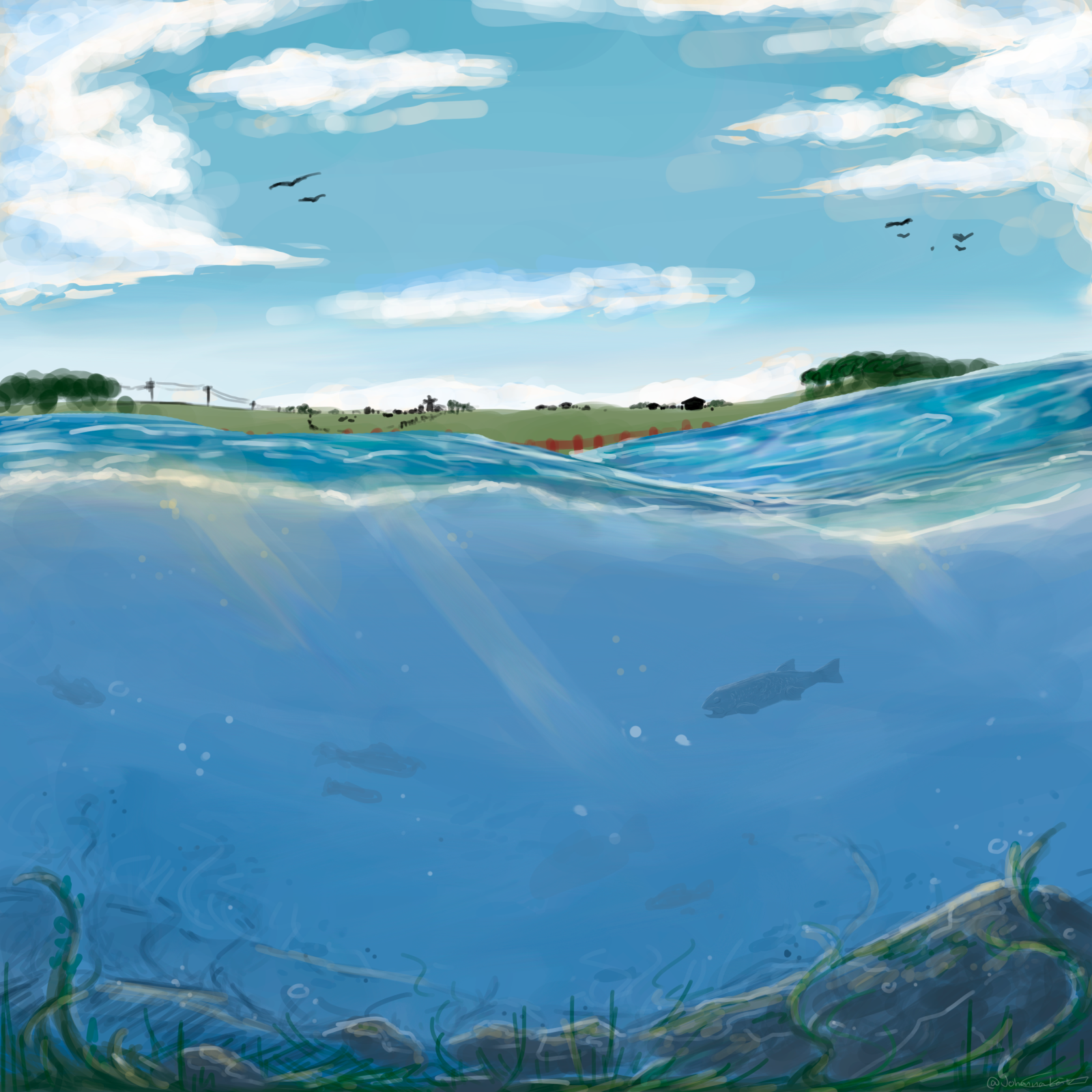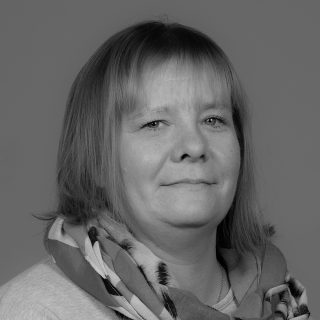At the Oulu Museum and Science Centre, everyone is involved in the Regional Responsibility Museum work. Thirteen people from our organisation participated in the implementation of our latest regional touring museum exhibition. In addition, sixteen cultural producers and volunteers from local heritage associations in North Ostrobothnia participated in two remote workshops to develop the content of the exhibition. The project also provided three internships for students from the Luovi and OSAO vocational schools.
Why are we making a touring exhibition?
I joined the Museum of North Ostrobothnia, part of the Oulu Museum and Science Centre, at the end of 2022 as a new museum researcher. My first task was to familiarise myself with the promotion of museums in our region and our plans for 2023–2026. One of our tasks is to develop and promote regional museum services. As a concrete step in this direction, the plans mention the design and construction of a travelling exhibition in 2023. Let’s get down to business, I thought, and started planning the exhibition at the beginning of 2023.
What do we have in common as North Ostrobothnians?
I knew from the start that the target audience for the exhibition would be pre-school children. In the past, our museum has produced portable exhibitions for children, but most of the regional travelling exhibitions have been aimed at adult visitors. Together with my colleagues, I thought a lot about what could unite such a large region in a way that would appeal to people from Kuusamo to Merijärvi and from Oulu to Nivala, and we ended up thinking about water.
There are several important rivers in the region, such as Rivers Iijoki, Kalajoki, Kiiminkijoki, Oulujoki and Pyhäjoki. On the other hand, Northern Ostrobothnia has relatively few lakes. The exception is Kuusamo, which has the Kitka lakes (Yli-Kitka and Ala-Kitka). Lake Oulujärvi, part of which is located in the municipality of Vaala, is the fifth largest lake in Finland. The province’s coastal region borders on the Bothnian Sea. For me, the river valleys, the lakes and the sea form a single whole that stretches across the whole of North Ostrobothnia.
What could the structure and content of the exhibition be?
We brainstormed content ideas together with museum curator Arja Keskitalo and museum educator Karoliina Autere from the Museum of Northern Ostrobothnia. I received invaluable help, sparring and support from them and others at the Museum of Northern Ostrobothnia throughout the exhibition project. For example, Arja suggested that the creation of a soundscape and “guessing” sounds might fit in well with the whole. By this time, I had written the framework story for the exhibition and started working on the script.
OULU ART MUSEUM’S ART CABINET AS A SOURCE OF INSPIRATION
At the same time, I began to think about the structure of the exhibition. Text titles? A suitcase? A story carpet? How should the water heritage of our region be presented to children? Tuija Visuri, the museum researcher in charge at the Oulu Art Museum, introduced me to the museum’s travelling exhibition concept. We looked at the art cabinets and I liked them. The upper part of the cabinet would have space for loudspeakers, the necessary technology and educational material. The folding doors could be decorated with colourful illustrations for children to admire, and the cabinet area would contain a water diorama. The plans became clearer. The next thing I wanted to do was to involve the cultural and museum workers in the municipalities of Northern Ostrobothnia in planning the content.
REMOTE WORKSHOPS FOR CULTURAL AND MUSEUM PROFESSIONALS
I felt it was important to involve the interest groups in our region in planning the exhibition. In the spring of 2023, I organised two remote workshops where we shared and recorded our thoughts about water-related cultural heritage on the Padlet platform. We reflected on stories about water as well as people, landscapes, objects, sounds and memories. The workshops were attended by people from Alavieska, Haapavesi, Ii, Kalajoki, Kuusamo, Lumijoki, Merijärvi, Muhos, Nivala, Oulu, Pudasjärvi, Pyhäjoki, Pyhäntä, Raahe, Sievi, Taivalkoski and Vaala. From these workshops, Sievi’s dried fields of old river bed and Merijärvi’s laundry grandmother, mussels, salmon dams and river crayfish found their way into the final exhibition.
TRAINEES FROM LUOVI
Our curator Arja advised me to contact the Luovi Vocational College and offer the subject to a trainee. We easily found two suitable students for our project. Timi Annala made some of the guessing sounds for the exhibition and Johanna Kälkäjä made eight skilful cartoons based on a story I had written. The trainees worked in two periods, starting in the spring and finishing in the autumn. Cooperation with schools is important for the Regional Responsibility Museum. We are lucky to be able to offer the students interesting topics, and in return we get content that we wouldn’t necessarily have thought of.
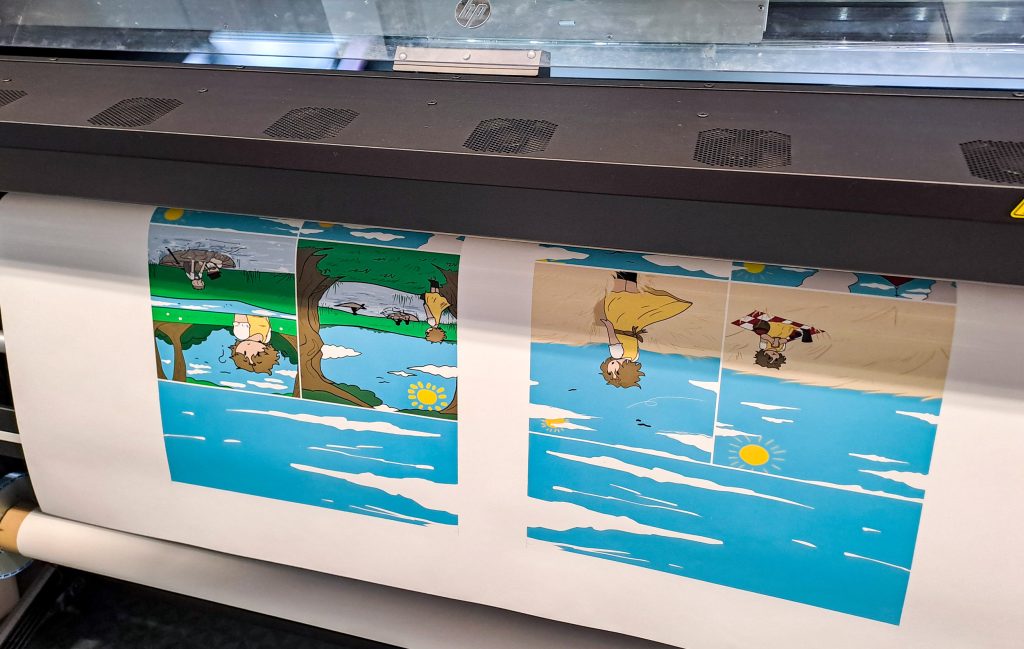
The comics on the doors were printed in Paavo Hiltunen's realm of technology. Photograph: Johanna Latvamäki
STICK PUPPET MAKER FOUND ON FACEBOOK
During the spring, I took part in a training course myself. In one of the training sessions, another participant talked about the finger puppets on her desk. What a great idea, and one that we might use, I thought. I tried to reach out to craftspeople in our area by e-mailing several organisations and also by asking my colleagues for tips. However, despite all my attempts, no doll maker could be found. I then came up with the idea to put a post on the museum’s Facebook page: ‘craft worker, come forward and join us in the realisation of our exhibition’. I was lucky enough to receive several contacts, through which I found a competent contractor.
Hannele Karppinen from Paltamo made the puppets according to my wishes. She suggested making stick puppets instead of finger puppets. This turned out to be a good solution and the characters’ expressions, clothes and stories came out better in a larger size than the original idea. When I got my hands on the puppets, I was overwhelmed with happiness. Children would be able to play with these wonderful puppets.
The themes of the puppets – the Ii River log floater, the wise minnow from Kuusamo, the bandit from Kives, the washerwoman from Merijärvi, the giant from Muhos, the Näkki, the sailing ship captain, the Taivalkoski riverman and the girl in rubber boots – came directly from the content of our remote workshops. Karppinen went on to study at the Piippola School of Arts and Crafts and also received a course credit for her commissioned work.
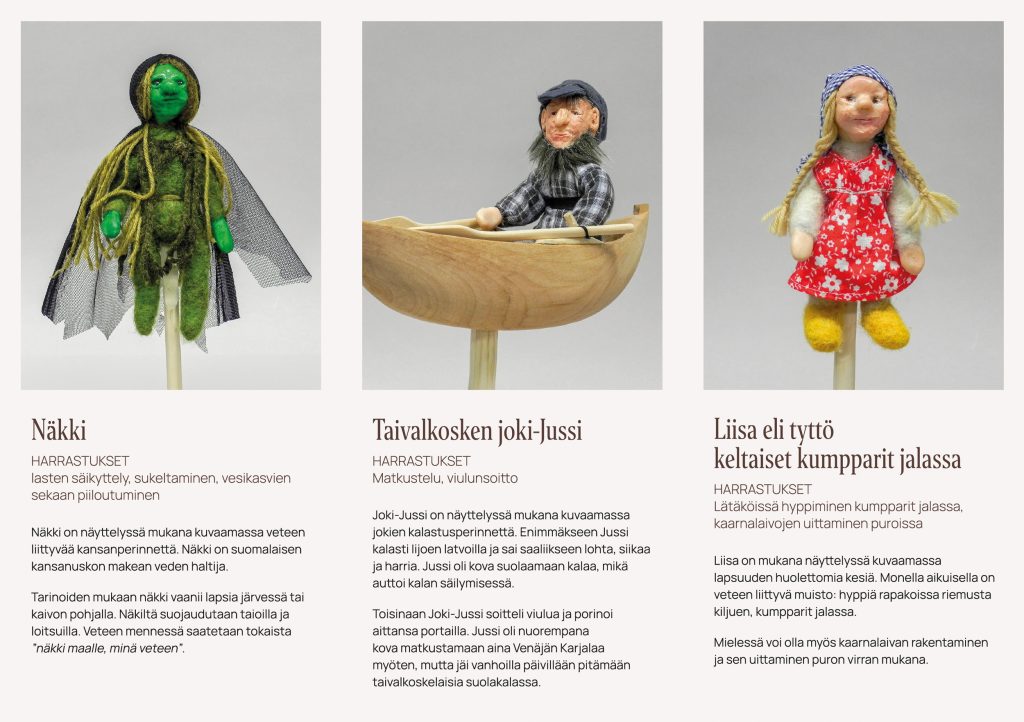
Stick Puppets by Hannele Karppinen. Layout and visual design of story cards by Juri Koivusilta. Texts and photos by Johanna Latvamäki.
DIORAMA MADE BY OSAO TRAINEES
The physical structure of the exhibition, the cabinet, was made by the exhibition technicians of the Oulu Museum and Science Centre, Mirva Ahmakallio and Tuomas Heikkilä. The next step was to find the maker of the diorama to be placed in the cabinet. We tried to find a suitable person to commission the work, but we couldn’t find one. At the same time, renovation architect Raimo Tikka told me that a student from OSAO was applying for an internship with us. I offered the diorama to Heidi Paaso-Rantala as an internship, and so this phase of the work also found its maker.
During her eight-week internship, Heidi designed and built a beautiful river landscape diorama based on my instructions. The salmon dam was made from bark found in the wild, peeled and oven-dried. The fish, mussels and crayfish were made from modelling clay and acrylic paint. Finnfoam panels, putty, paint, sand and an elaborate epoxy moulding process were used to build the diorama. In addition to myself, Heidi had the support and guidance of Mirva Ahmakallio, who also took care of the necessary orders and purchases.
The final result of the diorama is absolutely stunning. The detail and innovative working methods that Heidi has created deserve special praise. Thank you for a great job Heidi!
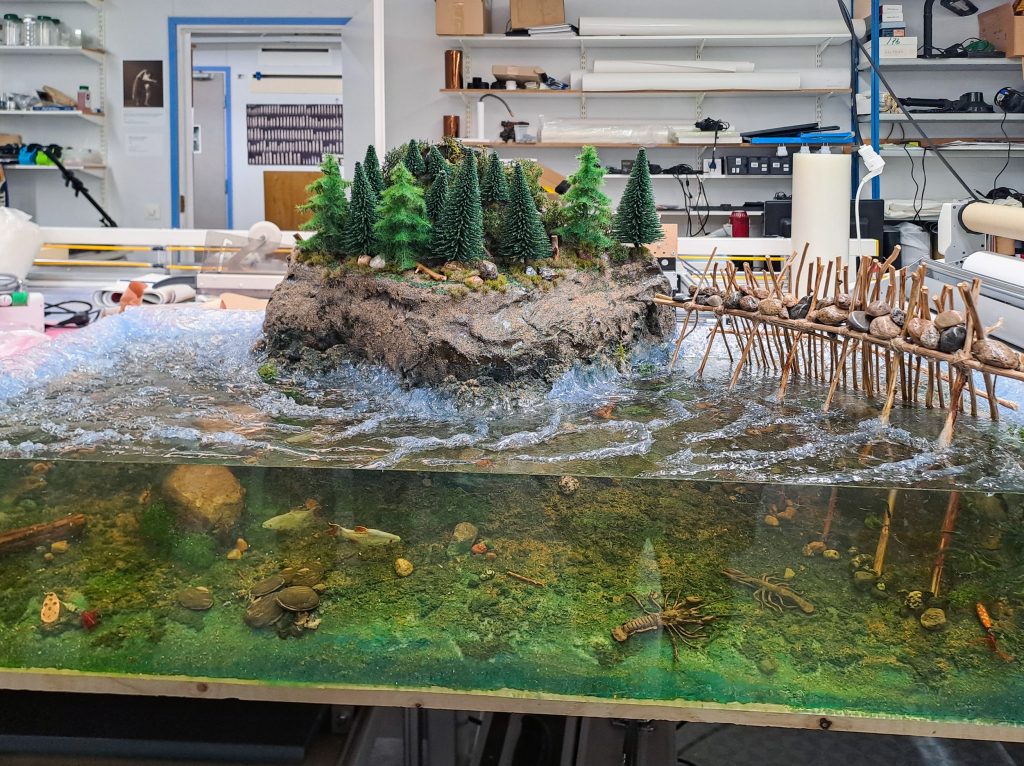
River landscape by Heidi Paaso-Rantala. Photograph: Johanna Latvamäki
IMAGE PROCESSING AND FINISHING
The prints for the display case were made while the diorama was taking shape. Heidi came up with an idea that the wallpaper could connect with the diorama and form a continuation of it. The photo of the Pyhäkoski rapids in Muhos came from the photo collection of the Museum of Northern Ostrobothnia. The picture was found by archivist Meeri Rauhala, who also helped us with other questions about the picture material. Heidi designed the lower part of the image, the part below the water’s surface, using an artificial intelligence program.
The Museum and Science Centre’s visual artist, Juri Koivusilta, transformed the black-and-white image into colour and combined the two images into a whole. Thanks to Juri’s visual eye, the exhibition’s comics have been turned into door prints and the stick puppet story cards have been given the look they deserve.
The wallpaper and the door photos were printed by exhibition technician Paavo Hiltunen.
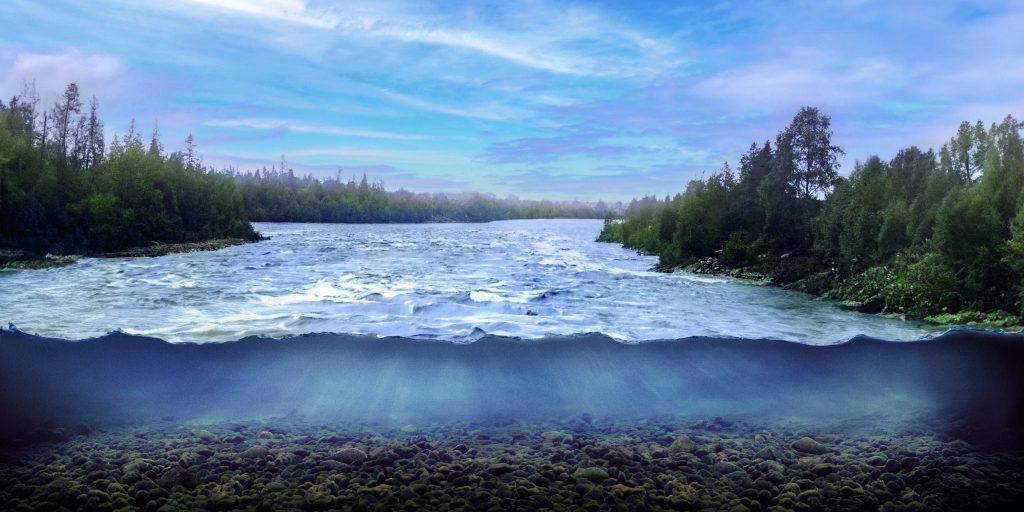
The top section is the archive image of the Pyhäkoski rapids in Muhos, while the bottom section is AI-generated. Image processing by Juri Koivusilta.
EARLY EDUCATION CULTURE GUIDE, DAY CARE TESTING AND PEDA MATERIALS
The City of Oulu’s cultural guide for early childhood education served as background and source material for the design. However, we also wanted to test the exhibition’s children’s materials in practice before the cabinet went into circulation. Together with museum director Karoliina Autere, we visited a day care centre in Pyykösjärvi, a partner of the Museum of Northern Ostrobothnia. The children were introduced to the stick puppets, the printed pictures and the story. The feedback from the kindergarten teachers was good, and after the water drawing exercise, we had some great pictures of beaches to admire. Even the stick puppet sea monster had been drawn! We felt we were on the right track with our ideas.
I wanted the children to use the stick puppets to create a drama theatre. Again, I needed the help of a colleague. Museum educator Riina Veijo designed the drama component of the exhibition, which also allows children to explore different emotional skills through play. Then the educational material for the exhibition began to come together.
VOICES AND STORIES RECORDED
Paavo Hiltunen was responsible for the sound engineering and research for the exhibition. Eight guessing sounds, a story and a stop button found their place in the sound panel designed by Paavo. As I write this blog post, there is a clap of thunder in the next room, then a fog siren as Paavo tests the sounds.
I asked my colleagues who would have the best narrator voice to read the story out loud on tape. The majority of respondents suggested building researcher Juhani “Jussi” Turpeinen as the reader. Jussi contributed to the exhibition by recording the story audio.
VISUAL STYLE AND LAYOUT
Anne Vähäsalo, graphic designer at the Oulu Museum and Science Centre, was responsible for the visual design and layout of the exhibition guide. And I think the end result is great! We hope that such a great brochure will motivate the users to familiarise themselves with the instructions and tasks.
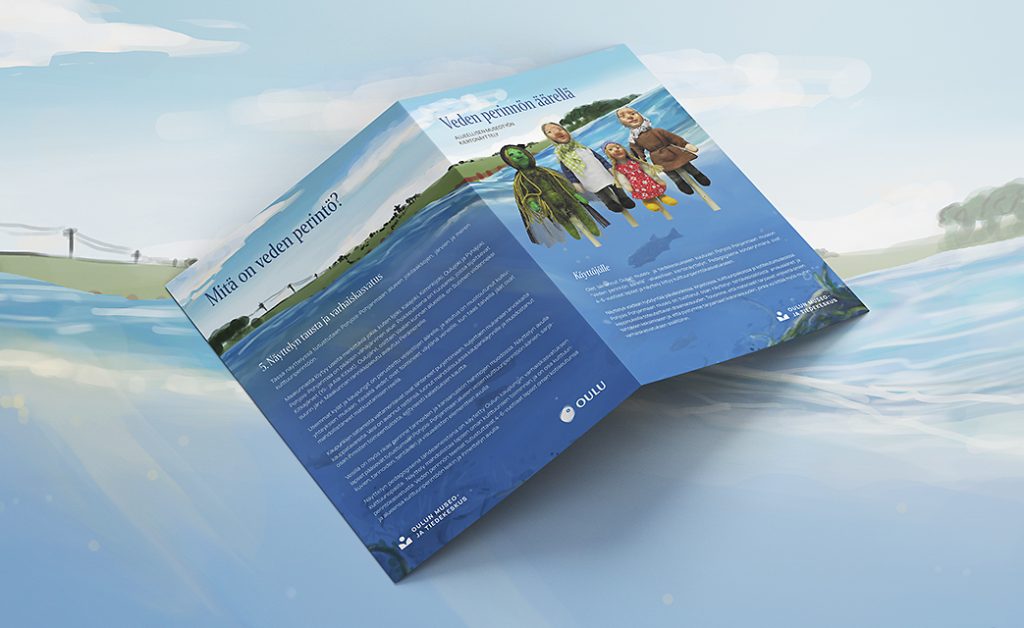
Exhibition brochure. Visual design and layout by Anne Vähäsalo. Texts by Johanna Latvamäki.
Exhibition goes on tour
The exhibition is now complete and ready to tour. Initially, it will be available on loan to the communities whose representatives helped shape exhibition’s content. It’s a bit wistful when you have to let go. Keeping to the schedule was challenging, and despite my wishes, the exhibition was not completed in 2023.
Exhibition projects are often hectic and the pressure of deadlines is intense. It is not uncommon for artworks to be hung and the last nails driven on the morning of opening day. The Water’s Heritage touring exhibition was a rare production in the sense that it was completed slowly, without pressure, alongside all our other work. The project was interesting, educational and I would definitely do it again.
Keep an eye out for the exhibition at the Pudasjärvi Local History Museum or the Kalajoki Library. I’m delighted that we can offer children fun and an opportunity to learn about the water-related cultural heritage of Northern Ostrobothnia.
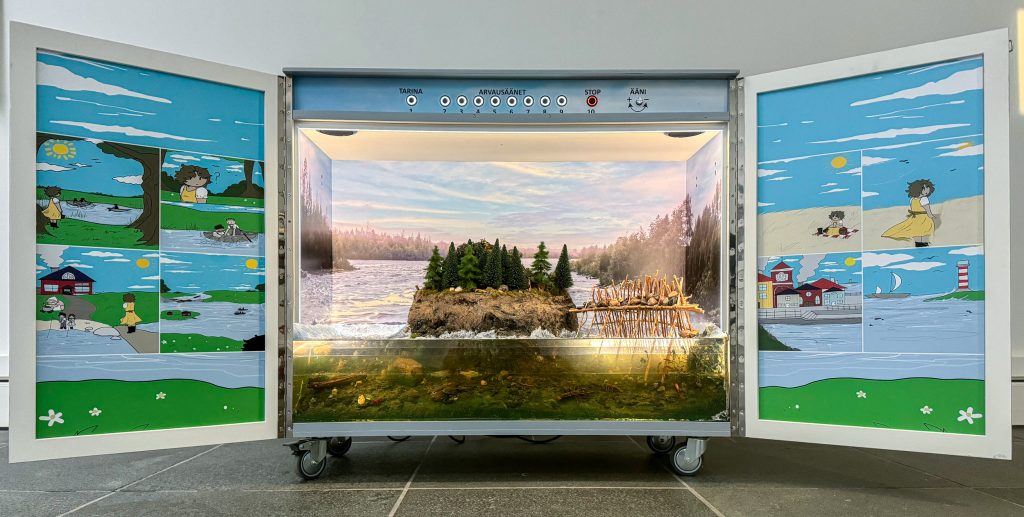
The complete travelling exhibition. Photograph: Mirva Ahmakallio.
Multi-professional exhibition team
As the responsible museum researcher, I, Johanna Latvamäki, wrote the script and texts for the exhibition, coordinated the project and brought the various parts of the production together. A single responsible museologist could not have done it all. Our skilled and imaginative staff, skilled craftspeople and enthusiastic trainees have made this wonderfully successful and varied exhibition possible. There is power in collaboration.
EXHIBITION CREATED BY:
The Oulu Museum and Science Centre is the museum responsible for museum work in North Ostrobothnia.
Collections
Meeri Rauhala, Archivist
Cultural Environment
Johanna Latvamäki, museum researcher, Northern Ostrobothnia Museum
Juhani Turpeinen, building researcher
Tuija Visuri, museum researcher, Oulu Art Museum
Technical team
Mirva Ahmakallio, exhibition technician
Paavo Hiltunen, exhibition technician
Mika Siekkinen, exhibition technician
Communications and Marketing
Juri Koivusilta, visualist
Inka Lohvansuu, communications assistant
Anne Vähäsalo, graphic designer
Audience Engagement
Karoliina Autere, museum educator
Arja Keskitalo, curator
Riina Veijo, museum educator
Contracted services
Hannele Karppinen, stick puppets
OSAO trainee
Heidi Paaso-Rantala, river landscape diorama
Vocational College Luovi trainees
Timi Annala, guessing sounds
Johanna Kälkäjä, comics
